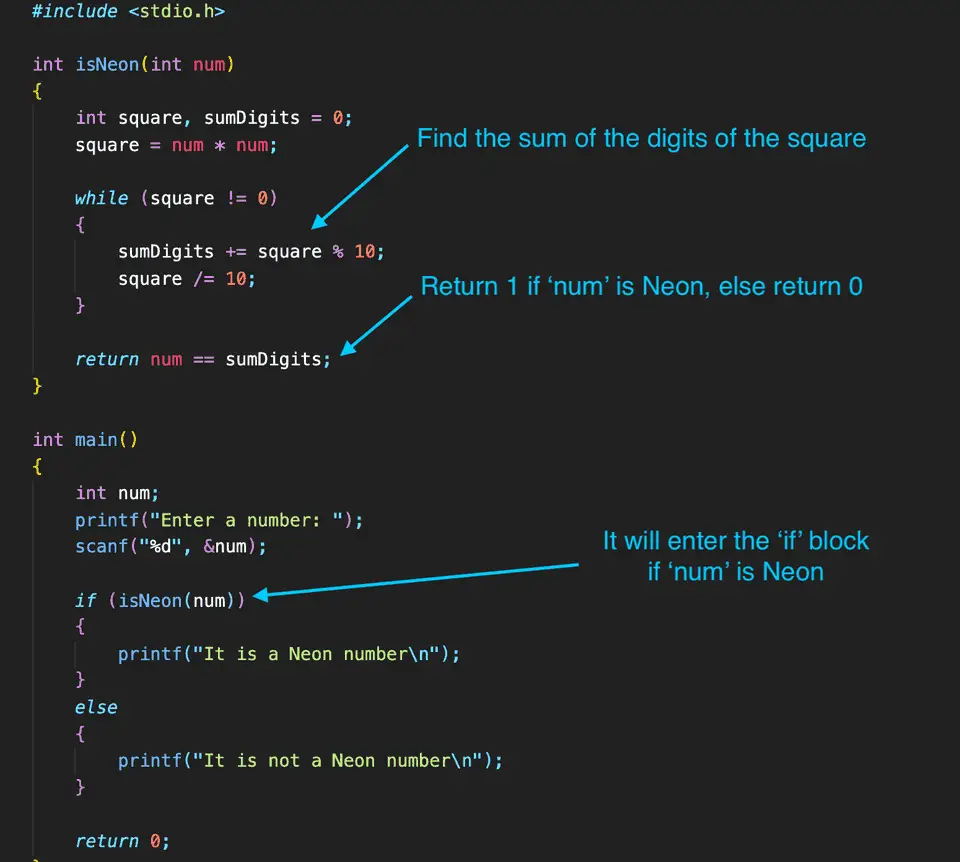C program to check if a number is Neon or not:
In this post, we will learn how to check if a number is a Neon number or not in C programming language. A number is called a Neon number if the sum of the digits of its square value is equal to the number.
For example, 9 is a Neon number because the square of 9 is 81 and 8 + 1 is equal to 9 that is the number.
This program will take a number as input from the user and print one message if it is a Neon Number or not.
Step to check if a number is Neon or not:
- Take the number as input from the user
- Find the square of the number
- Find the sum of the digits in the square
- Compare the sum with the number. If both are equal then it is a Neon number.
Now let’s write down the program:
Method 1: C program to check if a number is Neon or not:
#include <stdio.h>
int main()
{
int num, square, sumDigits = 0;
printf("Enter a number: ");
scanf("%d", &num);
square = num * num;
while (square != 0)
{
sumDigits += square % 10;
square /= 10;
}
if (num == sumDigits)
{
printf("It is a Neon number\n");
}
else
{
printf("It is not a Neon number\n");
}
return 0;
}In this program,
- num is an integer variable to hold the number
- square is an integer variable to hold a square value
- sumDigits is an integer variable to hold the sum of digits of the square. It is Initialised as 0
- The program is asking the user to enter a number and it stores that number in the num variable
- It finds the square of the number by multiplying the number with itself and stores that value in the square variable
- It uses a while loop to find the sum of digits in the square :
- The while loop will run until the value of square is not equal to zero
- It gets the last digit of square and adds it to sumDigits
- It removes the last digit from the square variable.
- After the loop, it checks if the number is equal to the sum of digits of the square value. If yes, it is a Neon number. Else, it is not.
If you run this program, it will give output as like below:
Enter a number: 9
It is a Neon number
Enter a number: 8
It is not a Neon numberMethod 2: C program to check if a number is Neon or not by using a different method:
Let’s use a different method to check if a number is Neon or not in C:
#include <stdio.h>
int isNeon(int num)
{
int square, sumDigits = 0;
square = num * num;
while (square != 0)
{
sumDigits += square % 10;
square /= 10;
}
return num == sumDigits;
}
int main()
{
int num;
printf("Enter a number: ");
scanf("%d", &num);
if (isNeon(num))
{
printf("It is a Neon number\n");
}
else
{
printf("It is not a Neon number\n");
}
return 0;
}Here,
- We created a new method called isNeon. This method is used to check if a number is Neon or not.
- It takes one integer variable as input and returns an integer.
- It uses the same steps that we did in the last program.
- It returns 1 if the number is Neon, else it returns 0.
- Inside main, we are calling isNeon in the if block. Based on its return value, we are printing a message.
Print all Neon numbers in a range:
We can use a loop and print all Neon numbers in a given range. Let’s find out all Neon numbers between 0 to 10000.
#include <stdio.h>
int isNeon(int num)
{
int square, sumDigits = 0;
square = num * num;
while (square != 0)
{
sumDigits += square % 10;
square /= 10;
}
return num == sumDigits;
}
int main()
{
for (int i = 0; i <= 10000; i++)
{
if (isNeon(i))
{
printf("%d ", i);
}
}
return 0;
}Here,
- We are using the same method isNeon as discussed in the previous example.
- The for loop runs from 0 to 10000. For each value, it calls isNeon to check if it is a Neon number or not. Since we are using i with the loop, it passes i to isNeon.
- If it is a Neon number, it prints that value.
If will print the below output:
0 1 9You might also like:
- C program to convert a string to hexadecimal value
- C program to swap two bits of a number
- C program to find the number of lines, words and characters in a string
- How to create a hollow diamond star pattern in C
- C program to print the size of the longest word in a string
- How to print the longest word of a string in C
- C program to convert binary values to octal

